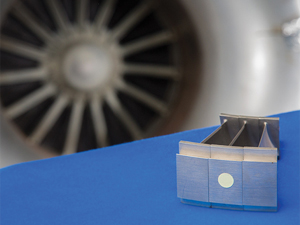



Date:23/04/16
 Aircraft icing, caused by soaring altitudes and high concentrations of ice crystal-laden clouds, continues to be a concern for the aviation industry. While buildup of these tiny crystals can cause damage to an aircraft engine or worse, researchers at the National Research Council of Canada (NRC) are addressing an industry-wide gap with the development of two new technologies designed to enhance ice particle detection.
Aircraft icing, caused by soaring altitudes and high concentrations of ice crystal-laden clouds, continues to be a concern for the aviation industry. While buildup of these tiny crystals can cause damage to an aircraft engine or worse, researchers at the National Research Council of Canada (NRC) are addressing an industry-wide gap with the development of two new technologies designed to enhance ice particle detection.
The Ultrasound Ice Accretion Sensor is a non-intrusive device that uses ultrasound technology to send out acoustic waves that provide data about conditions on the inside of an aircraft’s engine. What’s particularly innovative about the ultrasound senor is that it does not have to be placed within the environment being measured, ultimately eliminating the risk of damage caused by ice and debris.
Like the Ultrasound Ice Accretion Sensor, the NRC’s Particle Ice Probe is a small, lightweight device mounted to aircraft or engine surfaces and has no effect on fuel consumption or aerodynamics. The probe detects particles in the atmosphere around the aircraft by measuring changes in the electrical characteristics when flying in a high-altitude and ice crystal environment.
NRC’s development of two industry-leading ice particle detections technologies for high-altitude aircraft are both ready to leave NRC’s laboratories for the market, ultimately ensuring the highest level of aviation safety for us all.
NRC develops two industry-leading ice particle detection technologies
 Aircraft icing, caused by soaring altitudes and high concentrations of ice crystal-laden clouds, continues to be a concern for the aviation industry. While buildup of these tiny crystals can cause damage to an aircraft engine or worse, researchers at the National Research Council of Canada (NRC) are addressing an industry-wide gap with the development of two new technologies designed to enhance ice particle detection.
Aircraft icing, caused by soaring altitudes and high concentrations of ice crystal-laden clouds, continues to be a concern for the aviation industry. While buildup of these tiny crystals can cause damage to an aircraft engine or worse, researchers at the National Research Council of Canada (NRC) are addressing an industry-wide gap with the development of two new technologies designed to enhance ice particle detection.The Ultrasound Ice Accretion Sensor is a non-intrusive device that uses ultrasound technology to send out acoustic waves that provide data about conditions on the inside of an aircraft’s engine. What’s particularly innovative about the ultrasound senor is that it does not have to be placed within the environment being measured, ultimately eliminating the risk of damage caused by ice and debris.
Like the Ultrasound Ice Accretion Sensor, the NRC’s Particle Ice Probe is a small, lightweight device mounted to aircraft or engine surfaces and has no effect on fuel consumption or aerodynamics. The probe detects particles in the atmosphere around the aircraft by measuring changes in the electrical characteristics when flying in a high-altitude and ice crystal environment.
NRC’s development of two industry-leading ice particle detections technologies for high-altitude aircraft are both ready to leave NRC’s laboratories for the market, ultimately ensuring the highest level of aviation safety for us all.
Views: 637
©ictnews.az. All rights reserved.Similar news
- The mobile sector continues its lead
- Facebook counted 600 million active users
- Cell phone testing laboratory is planned to be built in Azerbaijan
- Tablets and riders outfitted quickly with 3G/4G modems
- The number of digital TV channels will double to 24 units
- Tax proposal in China gets massive online feedback
- Malaysia to implement biometric system at all entry points
- Korea to build Green Technology Centre
- Cisco Poised to Help China Keep an Eye on Its Citizens
- 3G speed in Azerbaijan is higher than in UK
- Government of Canada Announces Investment in Green Innovation for Canada
- Electric cars in Azerbaijan
- Dominican Republic Govt Issues Cashless Benefits
- Spain raises €1.65bn from spectrum auction
- Camden Council boosts mobile security





















